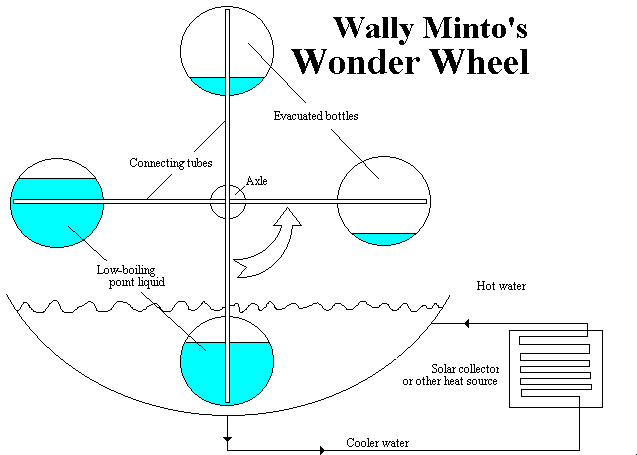Wally Minto's Wonder Wheel
04/30/97
From: Chuck Knight
Subject: Weird solar engine, buildable by hobbyists!
To: Bill Beaty
Date: Sun, 16 Jun 1996 00:12:59 -0500 (CDT)
Cc: Jerry Decker
Bill...Jerry...I wanted to send a copy of these files to you. They describe
the solar engine I just posted about to the freenrg-l list. I've included
the text file *and* the uuencoded graphic (hopefully this'll work). I'd
appreciate it if you could put them on the web sites...this one looks
do-able! Oh, Jerry, I also uploaded these files to the BBS, the other
night. -- Chuck Knight
Wally Minto's Wonder Wheel
by E. F. Lindsley
Popular Science, March 1976
Wally Minto's eyes twinkled. "Now that you've got your pictures of the
serious stuff, I want to show you our latest engine. It's at least 85%
effecient, never wears out, requires no fuel or maintenance, costs very
little, and should have been invented 100 years ago."
I'd just finished shooting pictures of Minto's solar-powered, Freon
engine/generator set (P.S. Feb 1976) and I wasn't quite sure if he was
kidding about this newest engine. Four - used propane bottles were hose-
clamped to the ends of two pieces of aluminum angle, each about four feet
long.
The angles crossed at 90 degrees at the center and were mounted on a
central hub like a skinny four-blade windmill with bottles to swing in
the breeze.
Each bottle was connected to its mate on the opposite end of the angle
with steel brake-line tubing. Under the rig's support was a tank of
the type used to locate leaks in an inner tube.
While I gazed in disbelief, Wally explained how his incredible power wheel
works (see diagram below - text is included at the end of this file).
A few weeks later I again visited the Kinetics Lab. By then the propane
bottles had evolved into 12 containers of steel pipe welded into a polygon.
The principle remained the same. I watched as Wally opened the valve to
let in a trickle of water from solar panels on the roof of his parking shed.
The water temperature was 155 degrees F.
Almost imperceptibly, the wheel started to turn. The speed picked up a
bit and I timed a revolution -- about one rpm. Minto noted my misgivings.
"Try holding onto the shaft," he said. I grabbed the shaft firmly -- it
was if I'd tried to stop some eerie, irresistible force: no sound, no
evidence of power, just pure twist.
"Picture one 200 feet in diameter," he said. This time my mind boggled.
Such a rig might hoist the pyramids.
Wally doesn't expect industrialized nations to scramble for his wheel,
and he isn't selling anything. He's donating it as a "gift to the
world" and expects it will be used in underdeveloped, energy short areas.
For example, a practical 33 ft. diameter wheel running on a temperature
difference of as little as 3.5 degrees F and producing several horsepower
could pump irrigation water, grind grain, or saw wood. The materials
could be scrap pipe, and no machining or skills are needed to build it.
Several low-boiling materials might be used, but propane or R-12 may be
best.
Minto estimates a slightly larger (40 ft.) wheel with 14 pairs of one-ft.
by 4.5 ft. containers would provide 10,240 ft/lb of work per container
as each 269 lb. of liquid responds to gravity through a 20 ft level arm.
At only one rpm this is 8.69 hp; not spectacular, but low cost and
capable of running steadily for generations. The slow rotational speed
can be stepped up to whatever is needed, just as with the old-time
waterwheels.
No fuel would be needed in many cases. The temperature difference required
between the liquid on the bottom and the top occurs naturally in many
situations: water and air, light and shade, etc.
Minto has outlined construction details in a two-sheet paper entitled
"The Minto Wheel." There are NO restrictions on building or experimenting
with the wheel.
Sun Power Systems, Inc.
1121 Lewis Ave.
Sarasota, Fla 33577
[sorry, no graphic for figure 1]
Polygon wonder wheel is made of individual containers. (Almost any
leakproof container can be used.) Tubes connect opposite pairs.
I wasn't sure it would run. It runs! Minto demonstrates wheel's torque;
simple pony brake on output wheel measures hp. Speed is about one rpm,
but torque is strong.
 Low-boiling liquid, such as freon or propane, fills one bottle of each
pair. The opposite bottle is empty and void of air. The liquid collects
in the lower bottle, which is immersed in warm (solar-heated) water.
Heat from the water (or a solar reflector, or any other source slightly
warmer than the surrounding air) vaporizes the liquid and forces part
of it up through the connecting tube and into the empty bottle on top.
Gravity does the rest:
The heavy bottle starts down; - the lighter bottle floats up.
As each pair shuttles its liquid mass back and forth, the whole thing turns
and repeats the process endlessly.
Low-boiling liquid, such as freon or propane, fills one bottle of each
pair. The opposite bottle is empty and void of air. The liquid collects
in the lower bottle, which is immersed in warm (solar-heated) water.
Heat from the water (or a solar reflector, or any other source slightly
warmer than the surrounding air) vaporizes the liquid and forces part
of it up through the connecting tube and into the empty bottle on top.
Gravity does the rest:
The heavy bottle starts down; - the lighter bottle floats up.
As each pair shuttles its liquid mass back and forth, the whole thing turns
and repeats the process endlessly.
